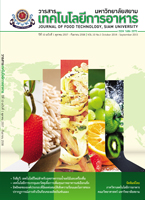ผลของอุณหภูมิและความสุกต่อค่าการนำไฟฟ้า ความชื้น และปริมาณของแข็งที่ละลายน้ำได้ของกล้วยน้ำว้าระหว่างกระบวนการให้ความร้อนแบบโอห์มมิค
Main Article Content
Abstract
การให้ความร้อนแบบโอห์มมิคเป็นทางเลือกหนึ่งที่อาจช่วยลดเวลาในการผลิตกล้วยตากซึ่งใช้เวลานานได้ เนื่องจากข้อมูลเกี่ยวกับค่าการนำไฟฟ้าของอาหารมีความจำเป็นต่อการออกแบบระบบการให้ความร้อนแบบโอห์มมิค ผลของอุณหภูมิและความสุกต่อค่าการนำไฟฟ้า ความชื้นและปริมาณของแข็งที่ละลายน้ำได้ของกล้วยน้ำว้าดิบและสุกจึงถูกศึกษา เพื่อให้สามารถใช้ในการออกแบบระบบในการผลิตกล้วยตากด้วยวิธีการให้ความร้อนแบบโอห์มมิคที่เหมาะสมต่อไป ผลการวิจัยแสดงให้เห็นว่า อัตราการเพิ่มของค่าการนำไฟฟ้าของกล้วยเพิ่มอย่างรวดเร็วในช่วง 40 – 60oC เมื่อวัดความชื้นของกล้วยที่บริเวณต่างๆ พบว่า การให้ความร้อนแบบโอห์มมิคช่วยลดค่าความชื้นของตัวอย่างในช่วงเริ่มต้นด้วยอัตราสูงสุดถึง 3.3 %/oC ในขณะที่ปริมาณของแข็งที่ละลายน้ำในกล้วยสุกจะเพิ่มขึ้นอย่างรวดเร็ว โดยกล้วยสุกมีปริมาณของแข็งที่ละลายน้ำได้มากกว่ากล้วยดิบประมาณ 10 เท่า จากผลการทดลองสามารถสรุปได้ว่า อุณหภูมิและความสุกของกล้วยมีผลต่อสมบัติของกล้วย โดยกล้วยสุกเหมาะที่จะนำมาผลิตกล้วยตากด้วยวิธีการให้ความร้อนแบบโอห์มมิค และอุณหภูมิที่คาดว่าจะเหมาะสมต่อการผลิตอยู่ในช่วง 60-65oC
Effects of Temperature and Degree of Maturity on Electrical Conductivity, Moisture Content and Total Soluble Solid of Banana (Musa sapientum Linn or “Nam wa”) during Ohmic Heating
Ohmic heating is an alternative heating method that may help shorten sun-dried banana production time which is generally long. As information on electrical conductivity of food material is necessary for a design of an ohmic heating system, effects of temperatures and degree of maturity on electrical conductivity, moisture content and total soluble solid of ripe and unripe bananas (Musa sapientum Linn or “Nam wa”) were investigated in order to design a proper ohmic heating system for sun-dried banana production. Results showed that increasing rate of electrical conductivity was high when the temperature of banana increased from 40 to 60oC. Total soluble solid of all samples increased rapidly during heating while total soluble solid in ripe banana was 10 times higher than that of unripe sample. It was also found that in the beginning period ohmic heating helped decrease moisture contents in the samples at a maximum rate of 3.3%/oC. In conclusion, temperature and degree of maturity affected banana’s properties. Ripe banana was suitable to be used as raw material in the production of sun-dried banana using ohmic heating and suggested heating temperature was between 60 and 65oC.
Article Details
Copyrights of all articles in the Journal of Food Technology available in print or online are owned by Siam University and protected by law.


